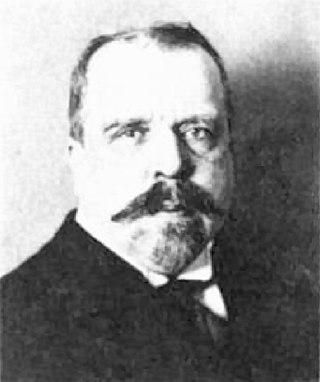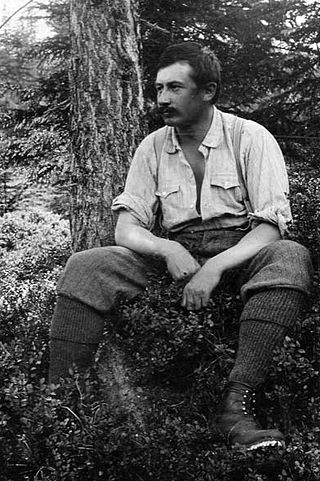
German East Africa was a German colony in the African Great Lakes region, which included present-day Burundi, Rwanda, the Tanzania mainland, and the Kionga Triangle, a small region later incorporated into Mozambique. GEA's area was 994,996 km2 (384,170 sq mi), which was nearly three times the area of present-day Germany and double the area of metropolitan Germany at the time.

Carl Peters was a German explorer and colonial administrator. He was a major promoter of the establishment of the German colony of East Africa and one of the founders of the German East Africa Company. He was a controversial figure in Germany for his views and his brutal treatment of native Africans, which ultimately led to his discharge as Reichskommissar in 1891.

Chief Mkwavinyika Munyigumba Mwamuyinga, more commonly known as Chief Mkwawa or Sultan Mkwawa, was a Hehe tribal leader in German East Africa, based in Kalenga, Iringa region, who opposed the German colonization. The name "Mkwawa" is derived from Mukwava, itself a shortened form of Mukwavinyika, meaning "conqueror of many lands". As a young child he was named Ndesalasi, meaning "troublemaker". As an adult he was named Mtwa Mkwava Mkwavinyika Mahinya Yilimwiganga Mkali Kuvagosi Kuvadala Tage Matenengo Manwiwage Seguniwagula Gumganga, meaning: "A leader who takes control of the forests, who is aggressive to men and polite to women, who is unpredictable and unbeatable, and who has the power that it is only death who can take him away."

Janenschia is a large herbivorous sauropod dinosaur from the Late Jurassic Tendaguru Formation of Lindi Region, Tanzania around 155 million years ago.

Gustav Adolf Graf von Götzen was a German explorer and Reichskommissar of German East Africa. He came to Rwanda in 1894 becoming the second European to enter the territory, since Oscar Baumann’s brief expedition in 1892, and later, he became the first European to cross the entire territory of Rwanda. Götzen was the last military governor of German East Africa before the colony was placed under civilian rule.

Oscar Baumann was an Austrian explorer, cartographer and ethnographer.
The Nena people are an African tribe first encountered in the last quarter of the 19th century in the north-east Livingstone Mountains in what is now Tanzania by two different European travellers. The Scottish explorer Joseph Thomson stumbled across them in 1879 during his journey from the East African coast to Lake Nyasa. Eighteen years later, in 1897, they were encountered a second time by the German priest Alphonse Adams.

Josef Felix Pompeckj was a German paleontologist and geologist.
Georg Julius Ernst Gürich was a German geologist, paleontologist and university teacher, who wrote on Paleozoic geological formations in Poland and ranged through Guinea, Tanzania and Southern Africa, in search of unrecorded new species.
Ferdinand Anton Franz Karsch or Karsch-Haack was a German arachnologist, entomologist and anthropologist.

Hans Paasche was a German politician and pacifist. He was the son of the Reichstag vice president Hermann Paasche and Lisi Paasche, and was married to Gabriele (Ellen) Witting.
The African gecko is a species of gecko found in Central Africa.
Paul Reichard was a German explorer who traveled extensively in Africa. His discoveries led to the establishment of the German East Africa Protectorate.

The Gregory Rift is the eastern branch of the East African Rift fracture system. The rift is being caused by the separation of the Somali plate from the Nubian plate, driven by a thermal plume. Although the term is sometimes used in the narrow sense of the Kenyan Rift, the larger definition of the Gregory Rift is the set of faults and grabens extending southward from the Gulf of Aden through Ethiopia and Kenya into Northern Tanzania, passing over the local uplifts of the Ethiopian and Kenyan domes. Ancient fossils of early hominins, the ancestors of humans, have been found in the southern part of the Gregory Rift.
Ernst Gustav Georg Teichmann was a German theologian and zoologist known for his investigations in the field of the tsetse fly and for his books on birth, fertilisation, heredity and death.

Walter von Saint Paul-Illaire or Adalbert Emil Walter Le Tanneux von Saint Paul-Illaire was a German colonial official in East Africa. He hailed from the noble family of Le Tanneux von Saint Paul, which had moved to Prussia in the 17th century. The genus Saintpaulia of the African violet was named in his honour after he discovered it in the Usambara Mountains and had sent its seeds in 1893 to Hermann Wendland, the German botanist and Chief Royal gardener at the Herrenhausen Gardens in Hanover, who gave the plant its first description, calling it the Usambara veilchen

Richard Hindorf,, was a pioneering German colonial agricultural scientist and traveller. He worked predominantly in German East Africa

Albrecht von Rechenberg, Albrecht Freiherr von Rechenberg or Georg Albrecht Julius Heinrich Friedrich Carl Ferdinand Maria Freiherr von Rechenberg was a German jurist, diplomat and a politician who served as Governor of German East Africa and as a member of the Imperial Diet.

Hassan bin Omari, also known as Makunganya, one of the Makanjila Yao people, was one of the most influential and successful Muslim ivory and slave traders and caravan raiders in present-day south-east Tanzania, and was a chief of the Mavuji. Having attacked the German occupying forces, he was eventually caught and hanged by German troops, along with his associates.

Otto Ampferer was an Austrian alpinist and geologist. To explain the complex processes of Orogeny, he developed his "theory of undercurrent" with the idea of a partially plastic earth's crust. He became – even before Alfred Wegener – the pioneer of the modern view of mobilism.














